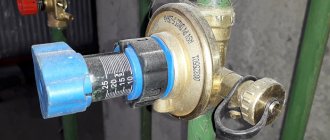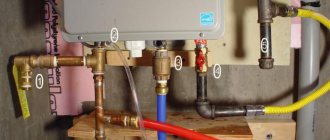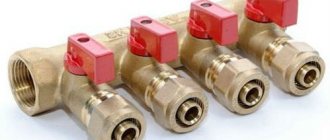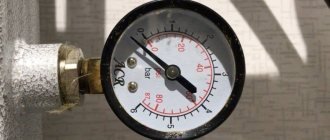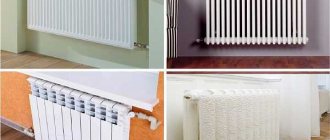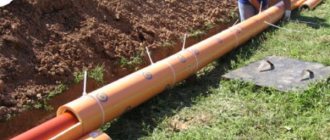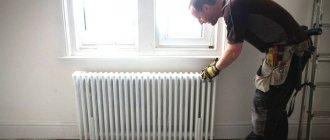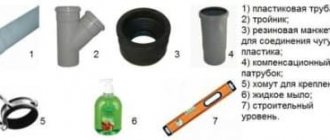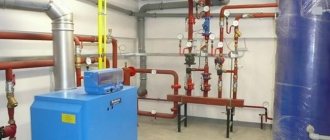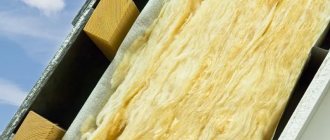Calculating the volume of water (coolant) filling the heating system will be one of the first things when choosing a boiler.
This is necessary to understand what optimal volume your boiler or other heat source can heat. The parameters of the pipes greatly influence this indicator: if you have a pump, you can safely choose a pipe of a smaller diameter and install more heating sections.
If you choose pipes of large diameter, then at maximum boiler power you can get underheating of the coolant: a large volume of water will cool down sooner before reaching the extreme points of the heating system. Which in turn will lead to additional financial costs.
An approximate calculation of the volume of water in the heating system is made from the ratio of 15 liters of water per 1 kW of boiler power.
To determine how much water is needed for a home heating system, consider a simple example.
The boiler power is 4 kW, then the system volume is 4 kW * 15 liters = 60 liters. But it is necessary to take into account the size and number of radiator sections.
If you have a house with 4 rooms, this does not mean that you need to put 12-15 sections in each: it will be very hot and the boiler will not work efficiently. If there are more rooms, then you shouldn’t save on radiators: 1 modern section effectively gives off heat for 2...2.5 m2 of area.
How can you simply determine what power a boiler needs for your home heating system?
Requirements for coolant in the heating system
There are 5 points that must be observed:
- high heat transfer rate;
- low viscosity , with standard (like water) fluidity;
- low expansion when cooling >;
- no toxicity >;
- low cost.
Photo 1. Eco-30 coolant based on propylene glycol, weight 20 kg, .
To make a choice, it is recommended to contact a professional plumber who will help you make calculations and select the appropriate coolant.
How to calculate consumption
The value represents the amount of coolant in kilograms that is consumed per second . It is used to transfer temperature to the room through radiators. To calculate, you need to know the boiler consumption, which is spent on heating one liter of water.
Formula:
G = N / Q , where:
- N - boiler power, W.
- Q —heat, J/kg.
The value is converted to kg/hour, multiplied by 3600.
Formula for calculating the required volume of liquid
Refilling of pipes is required after repair or reconstruction of the piping. To do this, find the amount of water needed by the system.
Usually it is enough to collect your passport data and add it up. But you can also find it manually. To do this, consider the length and cross-section of the pipes.
The numbers are multiplied and added to the batteries. The volume of radiator sections is:
- Aluminum, steel or alloy - 0.45 l.
- Cast iron - 1.45 l.
There is also a formula that can be used to approximately determine the total amount of water in the harness:
V = N * VkW , where:
- N - boiler power, W.
- VkW is the volume that is sufficient to transfer one kilowatt of heat, dm3.
This allows you to calculate only an approximate number, so it is better to check the documents.
To get a complete picture, you also need to calculate the volume of water held by other components of the piping: expansion tank, pump, etc.
Attention! The tank is especially important : it compensates for the pressure that increases due to the expansion of the liquid when heated.
First of all, you need to decide on the substance used:
- water has an expansion coefficient
- ethylene glycol — 4,5%;
- other fluids are used less frequently, so the data should be looked up in a reference table.
Formula for calculation:
V = (Vs * E)/D , where:
- E is the expansion coefficient of the liquid as stated above.
- Vs is the estimated flow rate of the entire piping, m3.
- D is the efficiency of the tank, indicated in the device passport.
Having found these values, they need to be summed. Typically, four volume indicators are obtained: pipes, radiators, heater and tank.
Using the data obtained, you can create a heating system and fill it with water. The filling process depends on the scheme:
- “Gravity flow” is performed from the highest point of the pipeline: a funnel is inserted and liquid is released. This is done slowly and evenly. First, open the tap below and place the container. This helps avoid the formation of air pockets. Used if there is no forced current.
- Forced - requires a pump. Any one will do, although it is better to use a circulation one, which is then used for heating. During the process, you need to take readings from the pressure gauge to avoid increasing pressure. And also be sure to open the air valves, which helps with the release of gas.
How to calculate the minimum coolant flow
They are also calculated as the liquid consumption per hour for heating the premises.
It is found during the break between heating seasons as a number that depends on the hot water supply. There are two formulas used in calculations.
If there is no forced circulation of hot water in the system, or it is turned off due to frequency of operation, then the calculation is performed taking into account the average flow rate:
Gmin = $ * Qgr / [(Tp - Tob3)*C] , where:
Qgsr is the average value of heat that the system transfers per hour of operation during the non-heating season, J.
$ is the coefficient of change in water consumption in summer and winter. 0.8 or 1.0 respectively .
Tp - supply temperature.
Tob3 - in the return when the heater is connected in parallel.
C is the heat capacity of water, taken equal to 10-3, J/°C.
Temperatures are taken equal to 70 and 30 degrees Celsius, respectively.
If there is forced DHW circulation or taking into account water heating at night:
Gmin = Qtsg / [(Tp - Tob6)*C], where:
Qtsg is the heat consumption for heating the liquid, J.
The value of this indicator is taken equal to (Ktp * Qgsr) / (1 + Ktp), where Ktp is the coefficient of heat loss by pipes, and Qgsr is the average power consumption for water per hour.
Tp - supply temperature.
Tob6 - return measured after the boiler circulating liquid through the system. It is equal to five plus the minimum allowable at the point of water collection.
Experts take the numerical value of the coefficient Ktp from the following table:
| Types of DHW systems | Loss of water by coolant | |
| Taking into account heating networks | Without them | |
| With insulated risers | 0,15 | 0,1 |
| Insulated and with towel rails | 0,25 | 0,2 |
| Without insulation, but with dryers | 0,35 | 0,3 |
Important! The calculation of the minimum flow rate can be found in more detail in building codes and regulations 2.04.01-85.
Heating standards RF PP No. 354 dated 05/06/2011 and GOST
On May 6, 2011, a Government Decree was issued, which is still in effect to this day. According to him, the heating season depends not so much on the time of year, but on the air temperature outside.
Central heating starts to work provided that the external thermometer shows below 8 °C and the cold snap lasts for at least five days.
On the sixth day, the pipes already begin to heat the rooms. If warming occurs during the specified time, the heating season is postponed. In all parts of the country, radiators delight with their warmth from mid-autumn and maintain a comfortable temperature until the end of April.
If frost has set in and the pipes remain cold, this may be the result of a problem in the system. In the event of a global breakdown or unfinished repair work, you will have to use an additional heater until the fault is fixed.
If the problem is due to air pockets filling the batteries, then contact the operating company. Within 24 hours after submitting the application, the plumber assigned to the house will arrive and “blow out” the problem area.
The standard and norms for permissible air temperature values are specified in the document “GOST R 51617-200. Housing and communal services. General technical information". The range of air heating in an apartment can vary from 10 to 25 °C, depending on the purpose of each heated room.
- Living rooms, which include living rooms, bedrooms, offices and the like, must be heated to 22 °C. This mark may fluctuate up to 20 °C, especially in cold corner rooms. The maximum temperature of the thermometer should not exceed 24 °C.
- According to the documents, the kitchen is classified as a work space. In addition, there is always an additional source of heat in it in the form of a gas or electric stove.
The optimal temperature is considered to be from 19 to 21 °C, but cooling the zone to 18 °C or intensive heating to 26 °C is allowed.
- The toilet follows the temperature range of the kitchen. But a bathroom, or an adjacent bathroom, is considered a room with a high level of humidity. This part of the apartment can warm up to 26 °C and cool down to 18 °C. Although, even with the optimal permissible value of 20 °C, it is uncomfortable to use the bathtub for its intended purpose.
- A comfortable temperature range for corridors is considered to be 18–20 °C. But, reducing the mark to 16 °C is considered quite tolerable.
- Indicators in pantries may be even lower. Although the optimal range is from 16 to 18 °C, marks of 12 or 22 °C are not outside the norm.
- Upon entering the entrance, the resident of the house can count on an air temperature of at least 16 °C.
- A person spends only a short time in the elevator, hence the optimal temperature is only 5 °C.
- The coldest places in a high-rise building are the basement and attic. The temperature here can drop to 4 °C.
Calculation of coolant volume in pipes and boiler
Heating system components
The starting point for calculating the technical characteristics of the components is to calculate the volume of water in the heating system. In fact, it is the sum of the capacity of all elements, from the boiler heat exchanger to the batteries.
How to calculate the volume of a heating system yourself, without involving specialists or using special programs? To do this, you will need a diagram of the location of the components and their overall characteristics. The total capacity of the system will be determined by these parameters.
Volume of water in the pipeline
A significant part of the water is located in pipelines. They occupy a large part in the heat supply scheme. How to calculate the volume of coolant in a heating system, and what characteristics of pipes do you need to know for this? The most important of them is the diameter of the line. It is he who will determine the water capacity in the pipes. To calculate, just take the data from the table.
| Pipe diameter, mm | Capacity l/p.m. |
| 20 | 0,137 |
| 25 | 0,216 |
| 32 | 0,353 |
| 40 | 0,555 |
| 50 | 0,865 |
Pipes of various diameters can be used in the heating system. This is especially true for collector circuits. Therefore, the volume of water in the heating system is calculated using the following formula:
Vtotal=Vtr1*Ltr1+ Vtr2*Ltr2+ Vtr2*Ltr2…
Where Vtotal is the total capacity of water in the pipelines, l, Vtr is the volume of coolant in 1 m.p. pipes of a certain diameter, Ltr – the total length of the pipeline with a given cross-section.
In total, these data will allow you to calculate most of the volume of the heating system. But in addition to pipes, there are other heating components.
For plastic pipes, the diameter is calculated based on the dimensions of the outer walls, and for metal pipes, based on the inner walls. This can be significant for thermal systems with a large extent.
Calculation of heating boiler volume
Heat exchanger of the heating boiler
The correct volume of the heating boiler can only be found out from the data in the technical passport. Each model of this heating device has its own unique characteristics, which are often not repeated.
A floor-standing boiler can have large dimensions. This is especially true for solid fuel models. In fact, the coolant does not occupy the entire volume of the heating boiler, but only a small part of it. All liquid is located in a heat exchanger - a structure necessary to transfer thermal energy from the fuel combustion zone to water.
If the instructions from the heating equipment have been lost, the approximate capacity of the heat exchanger can be used for calculations. It depends on the power and model of the boiler:
- Floor-standing models can hold from 10 to 25 liters of water. On average, a 24 kW solid fuel boiler contains about 20 liters in the heat exchanger. coolant;
- Wall-mounted gas ones are less spacious - from 3 to 7 liters.
Taking into account the parameters for calculating the volume of coolant in the heating system, the capacity of the boiler heat exchanger can be neglected. This figure varies from 1% to 3% of the total heat supply to a private home.
Without periodic heating cleaning, the cross-section of the pipes and the flow diameter of the batteries are reduced. This affects the actual capacity of the heating system.
Technical aspects of aluminum batteries
To install an autonomous heating system, it is necessary not only to carry out installation work in accordance with current regulations, but also to choose the right aluminum radiators. This can only be done after a thorough study and analysis of their properties, design features, and technical characteristics.
Classification and design features
Manufacturers of modern heating equipment make sections of aluminum radiators not from pure aluminum, but from its alloy with silicon additives. This allows the products to be corrosion resistant, more durable and extend their service life.
Today, the retail chain offers a wide range of aluminum radiators, differing in appearance, represented by such products as:
- panel;
- tubular.
According to the constructive solution of a single section, which are:
- Solid or cast.
- Extruded or composed of three separate elements, internally secured to each other with bolts with foam rubber or silicone gaskets.
Batteries are also differentiated by size.
Standard sizes with a width of 40 cm and a height of 58 cm.
Low, up to 15 cm high, which makes it possible to install them in very limited spaces. Recently, manufacturers have been producing aluminum radiators of this series of “plinth” design with a height of 2 to 4 cm.
Tall or vertical. With a small width, such radiators can reach a height of up to two or three meters. This working height arrangement helps to heat large volumes of air in the room quite effectively. In addition, this original design of radiators also performs a decorative function.
The service life of modern aluminum radiators is determined by the quality of the source material and does not depend on the number of its constituent elements, their sizes and internal volume. The manufacturer guarantees their stable operation with proper use for up to 20 years.
Main performance characteristics
Comparative characteristics
Technical characteristics and design solutions of aluminum radiators are developed to ensure convenient and reliable heating of rooms. The main components characterizing their technical properties and operational capabilities are the following factors.
Operating pressure. Modern aluminum radiators are designed for pressure levels from 6 to 25 atmospheres. To guarantee these indicators, in the factory, each battery is tested at a pressure of 30 atmospheres. This fact makes it possible to install this heating equipment in any heating system where the possibility of water hammer formation is excluded.
Power. This indicator characterizes the thermodynamic process of heat transfer from the surface of the heating battery to the environment. It indicates how much heat in watts the device can produce per unit time.
By the way, it occurs using the method of convection and thermal radiation in a ratio of 50 to 50. The numerical value of the heat transfer parameter of each section is indicated in the device passport.
When calculating the number of batteries required for installation, their power plays a primary role. The maximum heat transfer of one section of an aluminum heating radiator is quite high and reaches 230 Watts. This impressive figure is explained by the high heat transfer ability of aluminum.
This means that it requires less energy to heat it than its cast iron counterpart.
The temperature range for heating the coolant in aluminum batteries exceeds 100 degrees.
As a reference, a standard section of an aluminum radiator with a height of 350–1000 mm, a depth of 110–140 mm, with a wall thickness of 2 to 3 mm, has a coolant volume of 0.35–0.5 liters, and is capable of heating an area of 0.4– 0.6 square meters.
Formulas for calculating the volume of liquid in heating
The total volume of liquid will consist of the amount of coolant in the boiler, pipelines and batteries. The volume of the expansion tank is not taken into account here, because water will flow into this device only in critical cases when temperature and pressure increase.
To calculate the amount of liquid in a pipe, the following formula is used: V=S*L, where
S is the internal cross-sectional area of the pipe;
L – pipeline length.
Information regarding the cross-sectional area of the pipe taken from the tables may differ from the actual dimensions (material used, features of the production of plumbing products). That is why the diameter is measured with a caliper, after which the cross-sectional area is calculated. It is better to entrust such calculations to specialists, since heating systems are quite extensive and branched structures.
Selection of circulation pump
The circulation pump helps to identify pressure losses in all sections of the pipeline. To determine the pressure required by the pump to pump coolant through the system, use the formula: P = Rl + Z, where:
- P - decrease in pressure in the line (Pa);
- R - relative resistance to adhesion (Pa/m);
- l is the length of the pipe of one section of the heat pipeline (m);
- Z—pressure reduction in narrow-gauge zones (Pa).
Such calculations are extremely inconvenient and time-consuming, whereas to determine the Rl value of all sections of the pipeline it is enough to use Shevelev’s tables. It must be remembered that pump performance is the total coolant consumption, and not the capacity of the heating system.
Main types of coolants
There are four main types of fluid used to fill heating systems:
- Water is the simplest and most accessible coolant that can be used in any heating systems. Together with polypropylene pipes that prevent evaporation, water becomes an almost eternal coolant.
- Antifreeze - this coolant will cost more than water, and is used in systems of irregularly heated rooms.
- Alcohol-containing coolants are an expensive option for filling a heating system. A high-quality alcohol-containing liquid contains 60% alcohol, about 30% water and about 10% of the volume are other additives. Such mixtures have excellent antifreeze properties, but are flammable.
- Oil is used as a coolant only in special boilers, but is practically not used in heating systems, since the operation of such a system is very expensive. Also, the oil takes a very long time to heat up (it needs to be heated to at least 120°C), which is technologically very dangerous; at the same time, such a liquid cools down for a very long time, maintaining a high temperature in the room.
In conclusion, it is worth saying that if the heating system is modernized, pipes or radiators are installed, then its total volume must be recalculated according to the new characteristics of all elements of the system.
Snake or snail?
There are two main types of laying underfloor heating pipes - snake and snail (see figure). Although there is no fundamental difference between them in terms of pipe consumption.
A warm water floor laid in a snake pattern heats the room less evenly - the temperature of the floor in one part will be higher than in the other. Pipes are laid in this way when the room has a large window or a poorly insulated outer wall of the house.
The warmer part of the snake is placed where there is more heat loss. Sometimes the “corner snake” installation method is used (see figure).
The snail allows you to heat the entire room evenly. Heated floor pipes are laid in a snail pattern if the heat loss of the room is minimal - the walls are insulated, and the windows are at least two-chamber.
General calculations
It is necessary to determine the total heating capacity so that the power of the heating boiler is sufficient for high-quality heating of all rooms. Exceeding the permissible volume can lead to increased wear of the heating device, as well as significant energy consumption.
The required amount of coolant is calculated according to the following formula: Total volume = V boiler + V radiators + V pipes + V expansion tank
Boiler
Calculating the power of the heating unit allows you to determine the boiler capacity indicator. To do this, it is enough to take as a basis the ratio in which 1 kW of thermal energy is enough to effectively heat 10 m2 of living space. This ratio is fair in the presence of ceilings whose height is no more than 3 meters.
As soon as the boiler power indicator becomes known, it is enough to find a suitable unit in a specialized store. Each manufacturer indicates the volume of equipment in the passport data.
Therefore, if the correct power calculation is performed, there will be no problems with determining the required volume.
Pipes
To determine the sufficient volume of water in the pipes, it is necessary to calculate the cross-section of the pipeline according to the formula - S = π × R2, where:
- S – cross section;
- π is a constant equal to 3.14;
- R is the inner radius of the pipes.
Having calculated the cross-sectional area of the pipes, it is enough to multiply it by the total length of the entire pipeline in the heating system.
Expansion tank
You can determine what capacity the expansion tank should have by having data on the coefficient of thermal expansion of the coolant. For water this indicator is 0.034 when heated to 85 °C.
When performing the calculation, it is enough to use the formula: V-tank = (V system × K) / D, where:
- V-tank - the required volume of the expansion tank;
- V-syst - the total volume of liquid in the remaining elements of the heating system;
- K – expansion coefficient;
- D – efficiency of the expansion tank (indicated in the technical documentation).
Radiators
Currently, there is a wide variety of individual types of radiators for heating systems. In addition to functional differences, they all have different heights.
To calculate the volume of working fluid in radiators, you must first count their number. Then multiply this amount by the volume of one section.
You can find out the volume of one radiator using the data from the product technical data sheet. In the absence of such information, you can navigate according to average parameters:
- cast iron - 1.5 liters per section;
- bimetallic - 0.2-0.3 l per section;
- aluminum - 0.4 l per section.
The following example will help you understand how to correctly calculate the value. Let's say there are 5 radiators made of aluminum. Each heating element contains 6 sections. We make the calculation: 5 × 6 × 0.4 = 12 liters.
Calculation of system resistance and selection of circulation pump
When calculating the hydraulic resistance of a heating system, the option of natural coolant circulation along its contours is excluded. We consider only the case of forced passage of an extensive network of heating pipes along the thermal circuits. In order for the system to operate with a given efficiency, a sample pump will be required that will certainly guarantee the required pressure. This value is usually presented as the volume of coolant pumped in a selected unit of time.
To determine the total amount of resistance caused by the adhesion of water particles to the internal surfaces of pipes in the mains, the following formula is used: R = 510 4 V 1.9 / d 1.32 (Pa/m). The V sign in this relationship corresponds to the speed of the flow. When carrying out independent calculations, it is always assumed that this formula is valid only for speeds of no more than 1.25 meters/sec. If the user knows the current consumption of hot water, it is possible to use an approximate estimate to determine the internal cross-section of polypropylene pipes.
Upon completion of the basic calculations, you should refer to a special table, which indicates the approximate cross-sections of pipe passages depending on the figures obtained during the calculation. The most difficult and time-consuming procedure is to determine the hydraulic resistance in the following sections of an existing pipeline:
- in the areas where its individual elements meet;
- in valves serving the heating system;
- in valves and control devices.
After all the required parameters regarding the operating characteristics of the coolant have been found, we proceed to determining all other indicators of the system.
Home heating design
Step-by-step description of the heating installation processStep one
Equip a boiler room
The boiler room must be equipped in accordance with the requirements, so this issue must be taken seriously.
Calculate the power and type of boiler
The efficiency of the entire heating system depends on the boiler power. If you choose a weak boiler, then get ready for additional expenses.
Calculate the number of radiators and sections in them
This is also an important parameter; an insufficient number of radiators reduces the efficiency of the heating system.
Select radiator connection diagram
The connection system for heating radiators can be one-pipe, two-pipe, radial or made according to the Tichelman scheme
Boiler installation, piping, connection of radiators
At this stage, you should carefully consider the boiler piping scheme, connecting radiators, circulation pump, expansion tank and other elements
Filling the system with coolant and starting
At the last step, all that remains is to fill the system with water or antifreeze, and then start and test the heating system.
To ensure comfortable living in the cold season, even at the stage of designing a private house, you need to take care of the calculation and installation of heating. Correctly performed thermal calculations will allow you to determine the optimal and cost-effective heating system. Any error can lead to you freezing or the building becoming hot and stuffy.
Independent calculations will not be a problem for people with technical education. However, not everyone has physical and mathematical skills, so an online calculator will be a good guide to calculations. It will help identify heat losses at home and calculate the power that the boiler should have. It will also determine the number of radiators needed and how many sections it should have. It will calculate heating costs for you, which will be useful for choosing a suitable heat source. Collect the necessary data for the calculation.
Determine heat losses. To do this, you need to know what material the external walls and floor coverings are made of, how they are insulated and their thickness. Measure the area of the house, windows and exterior doors. High intensity of heat loss from ventilation and sewerage. They also need to be taken into account in the calculations.
The climatic conditions of the location of the house play an important role in the choice of heating system. Find out the average annual and minimum temperatures in your area, as well as the average wind speed.
Thermal loads - definition and characteristics
What is usually meant by the term “heating load”? This is the amount of heat that is given off by all heating devices installed in the building. To avoid unnecessary expenses on work, as well as the purchase of unnecessary equipment and materials, a preliminary calculation is necessary. With its help, you can adjust the rules for installing and distributing heat throughout all rooms, and this can be done economically and evenly.
But that's not all. Very often, experts carry out calculations relying on exact indicators. They relate to the size of the house and the nuances of construction, which takes into account the variety of elements of the building and their compliance with the requirements of thermal insulation and other things. It is accurate indicators that make it possible to correctly make calculations and, accordingly, obtain options for distributing thermal energy throughout the premises as close to ideal as possible.
But errors in calculations often occur, which leads to ineffective heating operation as a whole. Sometimes it is necessary to redo not only circuits, but also sections of the system during operation, which leads to additional costs.
What parameters influence the calculation of the thermal load as a whole? Here it is necessary to divide the load into several positions, which include:
- Central heating system.
- Underfloor heating system, if one is installed in the house.
- Ventilation system - both forced and natural.
- Hot water supply to the building.
- Branches for additional household needs. For example, for a sauna or bathhouse, for a swimming pool or shower.
Main characteristics
Professionals do not lose sight of any little detail that may affect the correctness of the calculation
Hence, there is a fairly large list of characteristics of the heating system that should be taken into account. Here are just a few of them:
The purpose of the property or its type. It can be a residential building or an industrial one. Heat energy suppliers have standards that are distributed according to the type of building. They are often the basis for calculations. Architectural part of the building. This can include enclosing elements (walls, roofing, ceilings, floors), their overall dimensions, thickness
All kinds of openings must be taken into account - balconies, windows, doors, etc. It is very important to take into account the presence of basements and attics. Temperature conditions for each room separately. This is very important because general temperature requirements for a home do not provide an accurate picture of heat distribution. Purpose of the premises This mainly applies to production workshops where stricter temperature control is required. Availability of special premises
For example, in private residential buildings these could be baths or saunas. Degree of technical equipment. The presence of a ventilation and air conditioning system, hot water supply, and the type of heating used are taken into account. The number of points through which hot water is drawn. And the more such points, the greater the thermal load the heating system is exposed to. The number of people at the site. Criteria such as indoor humidity and temperature depend on this indicator. Additional indicators. In residential premises, you can highlight the number of bathrooms, separate rooms, and balconies. In industrial buildings - the number of shifts of workers, the number of days a year when the workshop itself operates in the technological chain.
Methods for calculating volume
The size of the internal space of batteries manufactured in accordance with GOST can be determined in two ways:
- Look at the technical documentation and find the desired number among the specified characteristics. Next, you need to carry out simple mathematical operations.
- Pour in water and measure its volume or weight.
Determining the volume using documentation
Initial numbers can be taken both from documentation with technical characteristics and from special tables compiled by manufacturers. In both cases, a certain indicator is indicated, which corresponds to the volume of water that can fit in a linear meter of radiator.
This specific indicator is the center distance. It refers to the distance that separates the upper and lower collectors. Many manufacturers produce batteries observing standard center distance values. Most often it is 30 and 50 cm.
Calculating the volume of water that can fit in a heating device manufactured in accordance with GOST involves the following steps:
- Determining the length of panel radiators or the number of sections of aluminum or bimetallic batteries with smooth internal walls (such walls can reduce hydraulic resistance).
- Determination of the volume of water per linear meter. To do this, in the table they look at such a characteristic as the interaxle distance. Opposite its value, they look for the volume of water. If the heating device is sectional, then find out how much water can fit inside one section.
- Multiplying the obtained values.
This method is quite difficult to use for tubular radiators and batteries made according to individual needs.
This is because for the first devices, manufacturers use various GOST-tested pipes. They have different diameters, wall thicknesses, and lengths. Therefore, there are no tables with average values of volume and distance between collectors. They are impossible to compose. Of course, documentation with technical characteristics, as well as a table compiled by the manufacturer, can come to the rescue. In addition to the center distance, it can also indicate the resistance of the heated liquid and the weight of the device with this liquid.
As for a heating device manufactured at the request of the client, there may not be technical documentation for it with very detailed characteristics. After all, it is produced only in a small batch, and there is no point in calculating all the characteristics, including volume and water resistance.
Average volume values
For example, radiators with a center distance of 500 mm are taken. So the volume is:
- 1.7 liters for each section of the ChM-140 cast iron radiator designed for high pressure;
- 1 liter for each section of the same battery, however, a new model;
- 0.25 l for every 10 cm of panel device type 11. For structures with two and three panels designed for low pressure, this figure is 0.5 and 0.75 l per 10 cm;
- 0.45 liters for each lightweight aluminum battery section.
- 0.25 l per section of a bimetallic radiator manufactured in accordance with GOST.
Universal method
It is suitable for any type of heating device with any center distance. To implement it, you need to stock up on a large amount of water and a container, the volume of which is known.
The measurement is carried out as follows:
- Install plugs on the two lower holes. It would be possible to install a third plug on one of the top holes, but it is better to wait. This is because when you pour water into one hole, air must escape through the other.
- Pour water until it begins to flow out of the second free hole.
- Place a plug on this hole and slowly add water until the entire battery is completely filled. During pouring, count the number of containers poured. This can also be done while draining water from the radiator. True, you will have to drain the water into a bucket or something else and then pour it out.
- Multiplying the number of containers poured by their volume. The final figure is the volume released according to GOST rules of the battery.
How many liters of water are in a pipe with a diameter of 50, 32, 20, 16 mm (1 meter long)?
The volume of coolant in various pipelines, such as low-pressure polyethylene (HDPE pipe), polypropylene pipes, metal-plastic pipes, steel pipes, must be known when selecting any equipment, in particular an expansion tank.
For example, in a metal-plastic pipe with a diameter of 16, a meter of pipe is 0.115 g. coolant.
Did you know? Most likely no. And why should you know this until you are faced with the selection of, for example, an expansion tank. Knowing the volume of coolant in the heating system is necessary not only for selecting an expansion tank, but also for purchasing antifreeze. Antifreeze is sold undiluted to -65 degrees and diluted to -30 degrees. Once you know the volume of coolant in the heating system, you can buy an even amount of antifreeze. For example, undiluted antifreeze must be diluted 50*50 (water*antifreeze), which means that with a coolant volume of 50 liters, you.
In order to find out how much liquid is in one meter of pipe, there are special tables, including those attached to the pipes. For example, in one meter of pipe with an internal diameter of thirteen point two millimeters, the liquid volume will be zero point one hundred thirty-seven thousandths of a liter. But for example, for a pipe with an internal diameter of about seventy millimeters, the volume of liquid will be about four liters. Thus, knowing the length of the pipeline, you can obtain the final value by multiplying the volume of liquid per meter of pipe by the entire length of the pipeline. It should also be taken into account that in addition to the pipeline, the liquid in the system is also contained in radiators, manifolds, and other units and fittings.
To find out the amount of water in a pipe, you can, of course, calculate the area, then the volume, and then calculate how much there is in total, but you can do it much simpler.
You need to know what kind of pipe you have and its.
Sometimes it is necessary to calculate the amount of water that is in a heating pipe or water supply pipe, or simply calculate the volume of the pipe. So the pipe is a geometric figure - a cylinder, but of great height, in the case of a pipe it is length. To calculate how much water is in the pipe, you need to use the formula for calculating the volume of a cylinder. The volume of the cylinder is calculated as follows.
The widespread use of metal-plastic pipes in domestic water supply and heating systems has become possible thanks to a unique design that combines the positive features of metal and plastic pipes at the same time.
Metal-plastic pipes - the technical characteristics of which, despite the popularity of the products, are not familiar to everyone, are distinguished by high anti-corrosion properties, flexibility and remain just as durable. In this article we will give a more detailed description of metal-plastic pipes, describe their structure and features of use.
Metal-plastic pipes and fittings for their connection
Construction of metal-plastic pipes
Composition of metal-plastic pipes
The base of a metal-plastic pipe is the inner layer of polyethylene, which gives the pipe strength and performs a load-bearing function.
A layer of aluminum foil is attached to it using an adhesive composition, which prevents diffusion.
Correctly determining the diameter of the pipes for the internal pipeline is no less important than choosing the material for the pipes. After all, the insufficient diameter of the pipes causes turbulence (tortuosity) of the water flow in them. As a result, the movement of water in the pipe will be accompanied by strong noise, and large quantities of lime deposits will be deposited on its inner surface.
You need to know that two meters per second is the maximum speed of fluid movement in the plumbing system. This is what you need to base your calculations on when choosing the diameter of the pipes for the water supply. Based on this, the following main dependencies are determined.
How does the length of the pipeline affect the choice of pipe diameter?
• If the pipeline length is less than ten meters, then a pipe diameter of 20 mm will be sufficient. • The length of the pipeline is more than thirty meters and requires the use of pipes with a diameter of 32 mm. • For pipeline whose length is between 10 and 30 meters, it is better to use.
Non-standard solutions
When laying heated floors, the “double snake” method can be used. It allows you to heat the entire room evenly. In terms of efficiency, this option is no different from the “snail”.
In large rooms, heated floors with one circuit are ineffective. Experts agree that the length of pipes should not exceed 100-120 linear meters (depending on the diameter of the pipe). This corresponds to a room with an area of 20-24 sq.m.
If you need to heat a larger room with warm floors, you need to make additional circuits (see photo). Moreover, they can be laid either like a snake or like a snail.
Calculation of polypropylene pipes
In order to install the optimal heating or plumbing system in a particular room, a preliminary calculation of its operating parameters is made. The most important point here is the correct choice of pipe diameter. Such calculations ensure future energy savings and at the same time efficient operation of pipeline systems. These calculations are made using special formulas, as well as using previously developed tables. This work is called hydraulic calculation.
During this calculation, the amount of pressure loss to suppress hydraulic resistance inside the pipeline is determined. This resistance occurs at connections, branches and turns of the pipeline. However, the strongest pressure resistance occurs in places where there is a transition from a larger diameter pipe to a smaller diameter pipe. At this point, a throttling effect occurs, which is always accompanied by resistance to the main flow. Hydraulic losses can be calculated using this table.
As we said at the beginning of the article, the internal diameter of the pipes is perhaps the main factor in ensuring optimal operation of the pipeline. The total volume of water circulating in the system per unit of time depends on it. The main parameter in hydraulic calculations is the internal, not the external, diameter of the pipes. Correct calculation of the internal diameter of pipes is especially important when installing heating and plumbing systems in multi-storey buildings. An error in calculations may result in residents of the upper floors being left without water and heat. The required internal diameter and permeability of polypropylene pipes is determined by the formula
where Qtot is the maximum water flow, Pi is a coefficient of 3.14, V is the water circulation speed in the pipeline.
Such calculations are not needed for private houses. Experience shows that the optimal diameter of plastic pipes for houses and cottages is 20 millimeters.
3.1.General information
The heat demand of heat-using consumers varies depending on meteorological conditions, the number of people using hot water in domestic hot water supply systems, and the modes of air conditioning and ventilation systems for heating units. For heating, ventilation and air conditioning systems, the main factor influencing heat consumption is the outside air temperature. The heat consumption supplied to cover the loads of hot water supply and technological consumption does not depend on the outside air temperature.
The technique of changing the amount of heat supplied to consumers in accordance with their heat consumption schedules is called a heat supply control system.
There are central, group and local regulation of heat supply.
One of the most important tasks in regulating heat supply systems is calculating operating schedules for various load control methods.
Regulation of the heat load is possible using several methods: changing the temperature of the coolant - a qualitative method; periodic shutdown of systems – intermittent regulation; change in the surface of the heat exchanger.
In heating networks, as a rule, central quality control is adopted for the main heat load, which is usually the heating load of small and public buildings. Central qualitative regulation of heat supply is limited by the lowest water temperatures in the supply pipeline necessary to heat the water entering the hot water supply systems of consumers:
for closed heating systems - at least 70°C;
for open heat supply systems - at least 60°C.
Based on the data obtained, a graph of changes in the temperature of the network water is constructed depending on the outside air temperature. It is advisable to perform a temperature graph on a sheet of A4 graph paper or using Microsoft Office Excel. The graph determines the control ranges based on the break point temperature and describes them.
2.3.2
.
Central quality regulation for heating load
Central quality regulation for heating load is advisable if the heat load for housing and communal needs is less than 65% of the total load of the area and with the ratio
.
With this method of regulation, for dependent connection schemes of elevator heating systems, the temperature of the water in the supply
and reverse
highways, as well as after the elevator
during the heating season is determined by the following expressions:
(2)
The calculation was made for value No. 1. For all others, the calculation was made using the formula proposed above; the results are listed in Table 3.
(3)
The calculation was made for value No. 1. For all others, the calculation was made using the formula proposed above; the results are listed in Table 3.
where t
— calculated temperature pressure of the heating device, 0 C, determined by the formula:
, (4)
Here
3 and
2 - calculated water temperatures, respectively, after the elevator and in the return line of the heating network, determined at
(for residential areas, as a rule,
3 = 95 0 C;
2 = 70 0 C);
— calculated temperature difference of supply water in the heating network
=
1 —
2 (5)
=110-70=40
- calculated temperature difference of network water in the local heating system,
(6)
Given different values of outside air temperatures t
n (usually
t
n = +8; 0; -10;
t
nr v;
t
nro) determine
01;
02 ;
03 and build a heating graph of water temperatures.
To satisfy the hot water supply load, the water temperature in the supply line
01 cannot be lower than 70 0 C in closed heating systems. To do this, the heating schedule is straightened at the level of the indicated temperatures and becomes a heating-domestic one (see example solution).
Outdoor air temperature corresponding to the break point of the water temperature graphs t
n ", divides the heating period into ranges with different control modes:
in range I with the range of outside air temperatures from +8 0 C to t
n “group or local regulation is carried out, the task of which is to prevent “overheating” of heating systems and unnecessary heat losses;
in ranges II and III with the range of outside air temperatures from t
n » to
t
nro central quality regulation is carried out.
Table 3 - Temperature graph
| Outside air temperature, tnr | Coolant temperature |
Soldering of polypropylene pipes
For this, a special soldering iron is used, on which nozzles are installed that can heat pipes of different diameters. One side of the nozzle heats the pipe from the outside and from the end; it is shaped like a small glass, and the second heats the connecting element (tee, angle or coupling).
The task is to simultaneously melt the outer part of the pipe and the internal cavity of the transition. It is at this moment that many novice plumbers make one significant mistake - they must not overheat the pipe and connector. This is fraught with the fact that the small internal hole intended for the flow of water is, at best, almost halved, which reduces the throughput of the pipe, and at worst, it seals it tightly. And then look for where it happened, it’s good if you haven’t had time to wall it up yet.
We insert the pipe and the “connector” into the nozzles, forcefully press them into it until it stops, count two or three seconds, remove the pipe from the soldering iron and connect the two elements together. Here you need to understand that the larger the diameter of the pipes being connected, the more time it takes to warm them up. Let's just say that 2-3 seconds of warming up is an axiom for a pipe ø20 (in the old days it is ½ inch), and for the subsequent diameter (ø25 or ¾ inch) the warming up time increases to 5-6 seconds. And so on with each diameter.
Then another nuance arises. Firstly, the elements to be joined must be held with force until the polypropylene hardens - as a rule, this is 15-20 seconds. Secondly, at the moment the polypropylene hardens, you need to hold it firmly and securely so as not to turn or move the pipe in the connector. If you disturb the joint at this moment, you're guaranteed to leak.
Droplets of water that may remain in the plumbing system during its repair or the addition of any elements have the same detrimental effect on the joint. The steam generated at high temperatures simply will not allow the polypropylene to combine into a single whole. In this case, ordinary bread crumb is used. It is packed into the pipe and gives several additional tens of seconds, during which you need to have time to solder everything. Subsequently, the crumb is completely dissolved by water, and there can be no talk of any plugs.
If you are soldering polypropylene pipes for the first time, it would be good to invite a person who has already done similar work as an assistant. Experience is of great importance, and in some moments, competent advice on how to properly solder polypropylene pipes can be very helpful.
At first, when mastering this type of work, soldering propylene pipes will not be done quickly at all. But you shouldn’t rush, because if you rush, the quality will suffer. Do you need leaks?
By gaining experience, you will learn to work more efficiently, and the time spent on soldering polypropylene pipes will be reduced.
Who knows, over time, having learned how to solder propylene pipes, you may want to improve not only the plumbing in your home, but also the sewerage and heating systems, and you will be able to help your friends in repairing communications.
Online calculator
From this publication you learned about the different types of installation of underfloor heating. About how they differ and in what cases it is better to use one or another option. We also told you how to calculate the length of underfloor heating pipes. We hope that the article was useful to you. Don't forget to share it with your friends!
Do you want to get help from a master, a specialist in this field? Go to the professional search portal. This is a completely free service where you will find a professional who will solve your problem. You do not pay for posting an ad, views, or choosing a contractor.
If you are a master of your craft, then register on Pro and receive a flow of clients. Your profit is just one click away!
Source
Properties of polypropylene pipes
It is joined by polydiffusion welding, the joint is a homogeneous material and is safe in terms of sealing. PP-R pipes have a high thermal elongation, so the installations also use multilayer polypropylene called STABI (pipe with aluminum insert with PP-R / Al / PP-R structure) or GLASS (PP-R pipe reinforced with glass fiber) also on market under the name PP-R / GF / PP-R). PP-R pipes are manufactured with different wall thicknesses with the same outer diameter due to the nominal pressure PN. In accordance with the old standard, three pressure series PN10, PN16 and PN20 were distinguished. In accordance with the PN-EN ISO 15874-1 standard, which defines the operating conditions and typical areas of application of plastic pipes, PP pipes have a new marking. see table 1 and table 2..
Table 3 Application range of PP-R pipes according to PN-EN ISO 15874-1
Pipe dimensions - the PN-EN 15784-2 standard gives dimensions for PP pipes with a diameter of up to 110 mm, in practice there are already larger pipe sizes produced by Aquatherm. with sizes DN 125, 160, 200, 250 and 315
Physical and mechanical properties of PP-R pipes
Polypropylene pipes are offered in the country by many companies in various system colors. In addition to pipes in straight sections, coiled pipes (16 and 20 mm diameters) are also available for roof approaches and even for underfloor heating installations. In addition, polypropylene consists of sewer pipes, gutters, manhole kinetics, and gutters in linear drainage systems. In general, this is a very common material.


